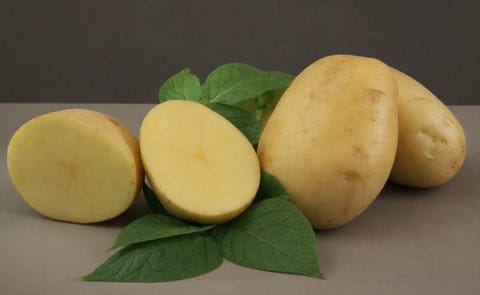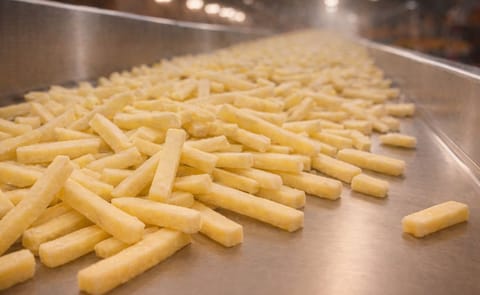Potato tuber with extensive blight infection
United Kingdom Potato Harvest 2017 without drama - but now the storage...

Feedback on this season’s harvest suggests that there are not too many dramas out there, although storage appears to be in short supply, probably because of a combination of high yields as many crops bulked quite late (hollow heart is a reported problem) and current market conditions reducing options to move crop off the field. If temporary or ‘overflow’ storage is being used, please note the information below about CIPC use.
There have been some isolated but, as yet, unquantified reports of rots including pink rot (Phytophthora erythroseptica) and [late] blight (Phytophthora infestans). These appear to be limited to areas where there was a lot of rainfall which may have impeded spray programmes and/or left waterlogged patches in the field to enable the fungi to spread. Slugs are also an issue in some areas.
It appears that these problems are not only affecting the UK. Interestingly, this photo of an extensive blight infection was tweeted by a Belgian research colleague in mid-October who described it as a ‘sting in the tail’, as tuber blight can often go unnoticed until the symptoms have developed in the store. Have you checked your crops? Suffice to say, there is no point in incurring further cost storing a crop like this with no prospect of sale.
New product labels tighten laws further on CIPC application
The latest changes to CIPC product labels, introducing new requirements for the use of lower application rates for this storage season, have been confirmed and have recently been communicated out to users by the Potato Industry CIPC Stewardship Group.

Make sure you use CIPC legally
As part of the CIPC Stewardship process, new label requirements have been advised, by all of the companies holding approvals, to ensure the use of best practice for application of the new rates. This is to help ensure compliance with the Maximum Residue Level (MRL of 10 mg/kg). As expected and communicated through the Group’s ‘Be 2017 Ready’ campaign, the labels now state that Stewardship Best Practice must be complied with, and so it is a legal requirement that both an NAAC Applicator is used to apply CIPC and active recirculation of the store air/fog takes place during and after treatment.
In high yielding areas, some growers have sought additional storage from neighbours and former producers. Ensure you have discussed crop ownership and responsibility for compliance in advance of application. Your NAAC applicator won’t be able to resolve these for you on the day of treatment.
New CIPC rates for 2017/18 season
As we highlighted in last month’s bulletin, for this season, the new statutory limits for total dose, approved by the Chemicals Regulation Division of HSE are 36 grams/tonne for processing (including fish & chip shop supplies and peeling) and 24 g/t for the fresh market.
The maximum individual dose is reduced to 12g/tonne. The latest time of application is 14 days before removal from store for sale or processing and is a statutory requirement. Additionally, Stewardship best practice, endorsed by the NAAC’s CIPC Applicator Group and Red Tractor Farm Assurance, continues to allow just one application (now up to 12 g/t) in cold stores as CIPC residue declines more slowly at low temperature. This applies to all stores that will be held below 5°C. This application should be made early in storage during pull-down, before the temperature is decreased below 7°C, for maximum efficacy.
No Fan No Fog
Critically, fans are now required as a compulsory part of the application process. CIPC must be actively recirculated during application and until the fog has cleared.

Fans are now required as a compulsory part of the CIPC application process. Air must be actively recirculated until the fog has cleared.
The NAAC CIPC Applicators’ Group has confirmed that applications will not be made if fog is not able to be recirculated. This is for residue control purposes as well as efficacy at the lower dose rates. In stores with positive ventilation (bulk stores and some box stores), active recirculation is most easily achieved by fitting an inverter (also known as a variable frequency drive or VFD) to use the store’s ventilation system at slow speed. In overhead throw box stores, active recirculation can be brought about using an air separator or duct at the end of the store to create an ‘open suction’ system. Alternatively, fan-assisted plenums placed within box stacks will ensure active recirculation can be achieved.
Different approaches are detailed in the PICSG’s CIPC Application: A Store Owner’s Guide, which is available at https://www.cipccompliant.co.uk/uploads/fileman/cipcapplicationguide.pdf It is recommended that users consult their NAAC CIPC Applicator to discuss this requirement now to ensure that, if steps have not yet been taken to modify stores, applications can still be made this season. For further information, see the PICSG ‘Be CIPC Compliant’ website – https://www.becipccompliant.co.uk or, for best practice advice, call the AHDB’s Storage Advice Line on 0800 02 82 111.
Finally, it is important to note any food, feed or seed, other than ware potatoes, should not be held in stores, which have been treated with CIPC. This is because CIPC penetrates the store fabric and is then re-released risking damaging seed and potentially contaminating food and feed. The Maximum Residue Level for CIPC in anything other than potatoes is the limit of detection (0.01 mg/kg). There is more information on this on the Red Tractor Farm Assurance website.










